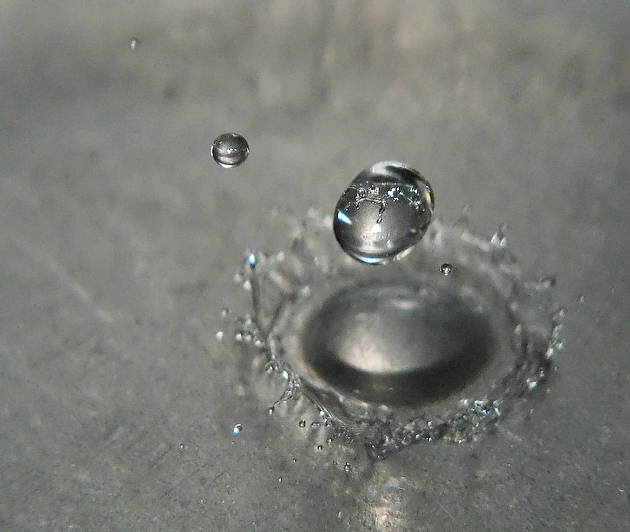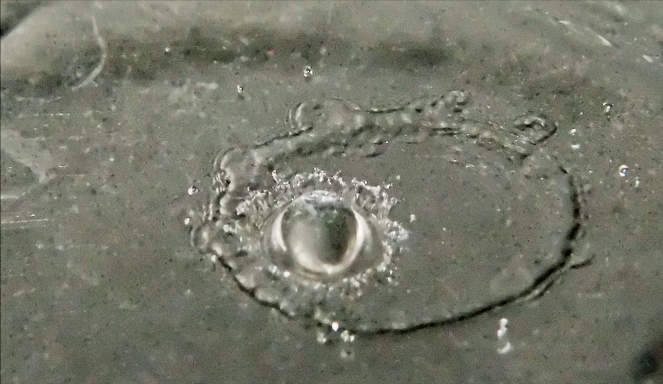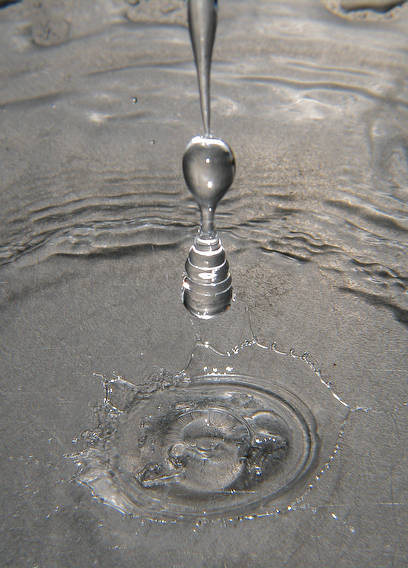m (Just a little centering touch-up so the latter photos look like the first.) |
m (correcting close-up lens diopter number 2 to 4. One character change.) |
||
| Line 11: | Line 11: | ||
These images were taken with the new high-speed shutter override option. |
These images were taken with the new high-speed shutter override option. |
||
| − | 1/10,000 second, Manual mode, f/3.5, flash manual at lowest output, + |
+ | 1/10,000 second, Manual mode, f/3.5, flash manual at lowest output, +4 diopter close-up lens, subject distance approx. 10 inches (25cm), room lights and lights above sink all turned on. |
Notice the greenish rectangular highlight in one of the drops. That is the fluorescent light over the sink. Giving these high-speed shots the appearance as if taken in available light alone. I really didn't spend any time learning to use this feature. Right after downloading Fingalo's Alpha build I popped it in the camera and headed to my kitchen sink to test it out. Some of these are within the first 5 shots taken. I got so enthralled I must have fired off another 40 more, then selected a few favorites from the bunch. These are just downsized images of the full frames, slightly cropped to get rid of some empty space around them so they look a little nicer. (I just did a hunt to see what the fastest shutter speeds are available on any other commerical digicams, the $2000-$20,000 ones go up to 1/8000 shutter speeds. And that's with the crippling limitation of using a focal-plane shutter so there's no high-speed flash sync. :-) ) |
Notice the greenish rectangular highlight in one of the drops. That is the fluorescent light over the sink. Giving these high-speed shots the appearance as if taken in available light alone. I really didn't spend any time learning to use this feature. Right after downloading Fingalo's Alpha build I popped it in the camera and headed to my kitchen sink to test it out. Some of these are within the first 5 shots taken. I got so enthralled I must have fired off another 40 more, then selected a few favorites from the bunch. These are just downsized images of the full frames, slightly cropped to get rid of some empty space around them so they look a little nicer. (I just did a hunt to see what the fastest shutter speeds are available on any other commerical digicams, the $2000-$20,000 ones go up to 1/8000 shutter speeds. And that's with the crippling limitation of using a focal-plane shutter so there's no high-speed flash sync. :-) ) |
||
Revision as of 21:08, 8 December 2007
Sample images of what can now be done with the ultra-high shutter speeds with high-speed flash sync.
A Drop in a Bucket, in a Sink, I mean in SYNC!
These images were taken with the new high-speed shutter override option.
1/10,000 second, Manual mode, f/3.5, flash manual at lowest output, +4 diopter close-up lens, subject distance approx. 10 inches (25cm), room lights and lights above sink all turned on.
Notice the greenish rectangular highlight in one of the drops. That is the fluorescent light over the sink. Giving these high-speed shots the appearance as if taken in available light alone. I really didn't spend any time learning to use this feature. Right after downloading Fingalo's Alpha build I popped it in the camera and headed to my kitchen sink to test it out. Some of these are within the first 5 shots taken. I got so enthralled I must have fired off another 40 more, then selected a few favorites from the bunch. These are just downsized images of the full frames, slightly cropped to get rid of some empty space around them so they look a little nicer. (I just did a hunt to see what the fastest shutter speeds are available on any other commerical digicams, the $2000-$20,000 ones go up to 1/8000 shutter speeds. And that's with the crippling limitation of using a focal-plane shutter so there's no high-speed flash sync. :-) )
On further investigation by others, it now appears that while the CCD electronic shutter timing is at (approximately?) 1/10,000th of a second duration, the flash is firing at speeds up to 1/60,000th of a second duration!! (see Dremel-drill speed test below) The CCD timing cutting out any blur from ambient lights and the flash freezing the motion. (Wow!)
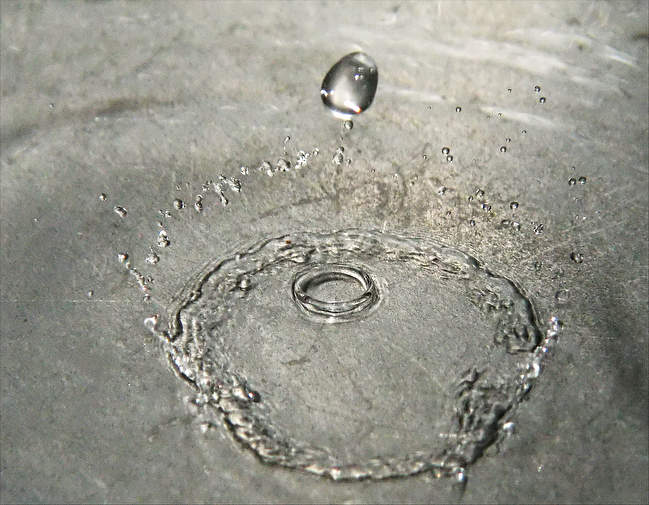
I like this one, look at that way cool perfect ring floating on the surface. I've never seen a formation like that in any drop photos.
This clearly shows the highlight from the fluorescent lamp above the sink. The other images also catching the greenish fluorescent ting. Giving these photos that available-light quality. I like the way that the back out-of-focus splash-ring from the previous drop is being refocused into clarity by the suspended drop that's next to hit. Very zen and fractal-like. The basis of optics and photography being performed by the inanimate(?) subjects themselves. :-)
I saw this one go by as I was taking shots and had hoped it would have turned out better. The drop still in shape but the bottom half already exploding beneath it. It's so hard to focus on running blurry water! Try it sometime. :-)
Looks like the typical milk-drop high-speed flash image that we all grew up with in photography and high-school science textbooks showing how the invention of xenon flash could show us things we never knew. And a fitting closure to this sequence.
Dremel-Drill Shutter/Flash Speed Test(s)
This image from an S2 IS PowerShot camera was submitted to test the true speed of the new ultra-shutter-speeds. However flash was used, so it is a better indicator of the flash-duration than shutter speed. What is important here to consider is that the camera's own flash synced with this high-shutter speed, extinguishing all ambient light from ruining the exposure and providing for optimum detail. Also, as the calculations will show, revealing some surprising results.
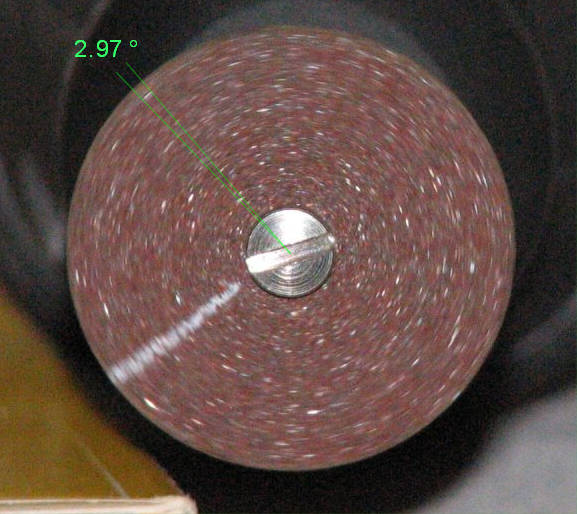
- (Contributor: "dudleydocker" from this discussion. Calculated Tv exposure was 1/8000, f3.5, at ISO 400)
A smaller well-defined highlight at the very edge of the disc's abrasive, one with easily discernible starting and stopping points, was used to better measure the angle of rotation. This way the measurement wouldn't also be thrown off by the diameter of that highlight that moved during the exposure.
Dremel Drill: 30,000 rpm = 500 rotations per second = 1 revolution every 1/500th second.
Motion blur: 2.97 degrees, let's safely round that to 3 degrees = 1/120th of a revolution.
This means that 120 units of measure can fit into a 1/500th of a second rotation.
500 x 120 = 60,000
The highlight's motion blur occurred during an exposure of 1/60,000th of a SECOND!
The image above is not just of a 1/8,000th nor even a 1/10,000th of a second exposure, but of 1/60,000th of a second effective shutter-speed. Xenon flash units usually control their flash output by duration rather than output level. So when used on the dimmest setting these cameras are shortening the flash output to 1/60,000th of as second.
How's that for high-speed flash-sync photography?
- [Addendum: It has now been discovered that these high CCD-shutter (as opposed to flash duration) speeds are F-stop dependent. In the same way that the camera's own firmware will only allow a shutter speed of 1/3200 at F/8.0. (On typing that just now, the camera's fastest native speed of 1/3200 seems agonizingly slow compared to the speeds we've been using and enjoying.) Aperture dependent: meaning CCD-shutter speeds of 1/8000 to 1/10,000 are only available at widest aperture. At smallest aperture f/7.1 - f/8.0 then CCD-shutter speeds as fast as 1/50,000 to 1/64,000 are available. That's yet another 8, 1/3EV steps. It has been very difficult to determine why some people were getting higher shutter-speeds during random testings. The only way to be certain is to use available-light sources alone (no flash). At F-stops that small and shutter-speeds that fast the light intensity has to be extreme, to say the least. Much brighter than sunlight. Once this new range of shutter-speeds are added to the CHDK Menu "Shutter Override" then high-speed flash will be able to be used as the light source for even more precise motion-stopping effects. The CCD-shutter matching the flash-duration and effectively obliterating any detail-smearing blur from ambient light sources completely.]
I have since been investigating other uses of high-speed flash on the internet, and ran across this little discussion, when someone was enquiring about photographing shot-gun spread-patterns from the side, and how fast of a flash would be needed. The reply is rather appropriate for this photo. They compared the edge speed of a Dremel-drill cut-off wheel with ballistics speeds.
I guess this means that if you wanted to, and had a way to sync your camera to a rifle shot, you could get one of those spectacular images of a bullet ripping through a playing-card, edge-wise.
Also worth noting in my net searches, most "high speed" flash units on the market rarely go above 1/50,000th of a second, more commonly about 1/20,000th to 1/30,000th of a second, at exorbitant cost.
1/60,000 Shutter-speed With CHDK "AllBest" Build
Well, the results are in. These were taken with the new AllBest CHDK build. Set at 1/60,000 of a second shutter speed, and testing various f/stops and flash-output levels. You can tell by an absence of any greenish highlights from the fluorescent light above that only flash was illuminating the water this time. The second image here was taken at f/8.0, so the flash had to be raised to the 2nd level of output. Much brighter and therefore a much longer duration than the previous images of 1/60,000 flash duration. But as you can see, this time the CCD shutter alone was able to stop the motion just as crisp as if the 1/60,000 of a second flash was used to halt all motion. I'd say that pretty much confirms that high of a shutter speed. Maybe it's time for a new battery of dremel-drill tests.
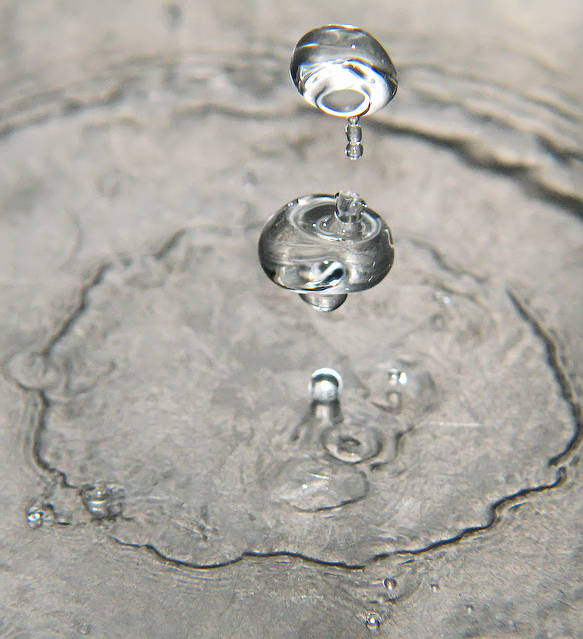
- 1/60,000, f/3.6, real shutter speed unknown
- 1/60,000, f/8.0, real shutter speed presumed 1/60,000
(if adding new images, please place them above this section, and leave this one at the bottom, thanks)
Links to other interesting high-speed flash photography:
(in progress of hunting down some of the best, wanna help?)
- High-speed flash photography of water and milk drops, done in stereo-pairs.
Speed of flash units for high speed flash photography
- Camparison shots of falling milk-drops (just the drop, no neat splashes) using various flash units and power settings.
High Speed Flash Hummingbird Photography
Electronic Guidebook for High-Speed Flash Photography
Martin Waugh's "Liquid Sculpture"
High Speed, Splashes, Dripping water, Schlieren and Photoinstrumentation Photographs
- Wow, cool site. A page of about 100 high-speed photography. (And other specialty "Schlieren" photography, look it up, it's interesting stuff, I used to do this using old telescope mirrors.) An excellent resource to give you some ideas of subjects you might want to try with your new high-speed possibilities. Be sure to visit the author's homepage for even more ideas of specialty photography ideas. Here's a link to his text articles describing more detail on how these methods are used. (The site is a little confusing so this link will help get you to that page.)

